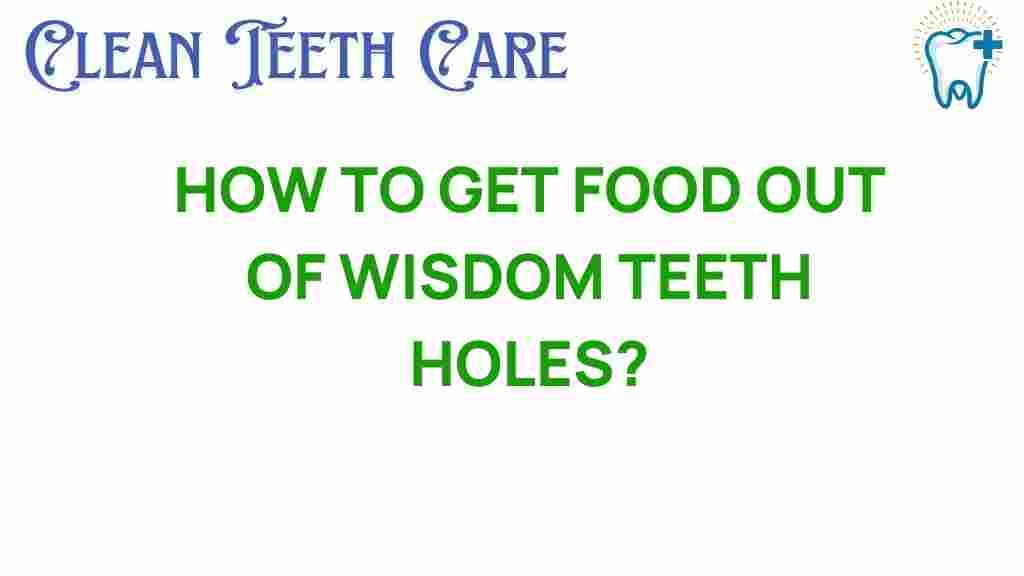Unveiling the Secrets: How to Clear Food from Wisdom Teeth Holes
Wisdom teeth removal is a common dental procedure that many people undergo in their late teens or early twenties. While this surgery can alleviate pain and prevent future dental issues, it can also lead to some challenges during the healing process, especially when it comes to maintaining oral hygiene. One of the most common concerns post-surgery is how to effectively remove food particles from wisdom teeth holes. In this article, we will unveil the secrets to clearing food from these holes while ensuring proper dental care and a smooth recovery.
Understanding Wisdom Teeth and Their Removal
Wisdom teeth, or third molars, typically emerge in late adolescence or early adulthood. Due to lack of space in the jaw, many individuals experience complications such as impaction, which can lead to pain, infection, and other dental problems. As a result, wisdom teeth are often extracted to prevent these issues.
The Importance of Oral Hygiene Post-Surgery
After wisdom teeth removal, maintaining proper oral hygiene is crucial. The extraction sites, or sockets, can easily trap food, leading to discomfort and potential infection. Here are some essential post-surgery tips to keep your mouth clean and promote healing:
- Follow your dentist’s instructions carefully.
- Use prescribed medications as directed.
- Keep the extraction site clean to avoid infection.
Step-by-Step Process for Food Removal
To effectively clear food from wisdom teeth holes, follow these steps:
Step 1: Wait Before Rinsing
In the first 24 hours after surgery, it’s crucial to avoid rinsing your mouth. This allows the blood clot to form properly, which is vital for healing.
Step 2: Begin Gentle Rinsing
After the first day, you can start rinsing your mouth gently with warm salt water. This helps to reduce swelling and promotes healing. Here’s how to do it:
- Dissolve 1 teaspoon of salt in 8 ounces of warm water.
- Gently swish the solution around your mouth for about 30 seconds.
- Spit it out carefully; avoid forcefully spitting to prevent dislodging the blood clot.
Step 3: Use Mouthwash
Incorporating an alcohol-free mouthwash can further enhance your dental hygiene routine. Look for a mouthwash that contains antiseptic properties to help reduce bacteria around the extraction site.
Step 4: Utilize a Syringe
After a few days, your dentist may provide you with a special syringe designed for flushing out food particles from the wisdom teeth holes. Here’s how to use it:
- Fill the syringe with warm salt water or a prescribed rinse.
- Gently insert the tip into the socket.
- Apply gentle pressure to flush out any trapped food particles.
Step 5: Maintain a Soft Diet
For the first week post-surgery, stick to a soft diet to minimize food particles getting stuck in the holes. Opt for:
- Mashed potatoes
- Yogurt
- Smoothies
- Applesauce
Troubleshooting Common Issues
Even with the best dental care, you may encounter some issues during the recovery process. Here are some common problems and solutions:
Problem 1: Persistent Pain or Swelling
If you experience prolonged pain or swelling beyond the first few days, it may indicate an infection or dry socket. Consult your dentist immediately if this occurs.
Problem 2: Food Still Stuck in the Holes
Sometimes, food may remain lodged in the extraction sites despite your best efforts. If you’re unable to remove it with rinsing or a syringe, seek guidance from your dentist.
Problem 3: Bad Breath
Bad breath can result from trapped food particles or bacteria. Maintaining rigorous dental hygiene and using mouthwash can help combat this issue.
Conclusion
Caring for your mouth after wisdom teeth removal is essential for a smooth recovery. By following the outlined steps for food removal and maintaining good oral hygiene, you can ensure that the healing process goes as smoothly as possible. Remember to listen to your body, adhere to your dentist’s instructions, and don’t hesitate to reach out if you experience any complications. For more information on dental care and recovery tips, visit this page. For additional oral hygiene resources, check out this link.
This article is in the category Treatments and created by CleanTeethCare Team
